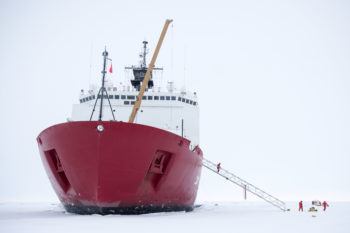
Texas A&M Scientists Find Trace Elements Increasing In Rapidly Changing Arctic Ocean
Significant quantities of carbon and trace elements are flowing across the central Arctic Ocean under the sea ice via freshwater runoff from rivers and continental shelf sediments, according to a new study by an international team of ocean scientists.
“This research is critical to understanding the current and future health of the Arctic Ocean, which is warming faster than much of the rest of the planet,” said Jessica Fitzsimmons, a co-author of the study and assistant professor in the Department of Oceanography at Texas A&M University.
“The Arctic is also receiving more freshwater with its changing climate, making an understanding of the chemistry and fate of that freshwater more important than ever before.”Texas A&M doctoral students Laramie Jensen and Tatiana Williford, along with Rainer Amon, professor of marine and coastal environmental science at Texas A&M – Galveston, were also co-authors of the study. Their results were recently published in the Journal of Geophysical Research-Oceans.

“Our team analyzed the concentrations of six nutrient metals, like iron and zinc, and one toxic contaminant metal, lead, and found that the nutrient metals are supplied by Arctic rivers and are directly transported across the center of the Arctic Ocean within a high-speed current,” Fitzsimmons said. “Fortunately, toxic contaminant fluxes in this study remained low and do not appear to be coming from Arctic rivers.”
The increased nutrients are carried by the Transpolar Drift — a major surface current that moves water from Siberia across the North Pole to the North Atlantic Ocean. In 2015, oceanographers conducting research in the Arctic Ocean as part of the International GEOTRACES program found much higher concentrations of trace elements in surface waters near the North Pole than in regions on either side of the current.
“Many important trace elements that enter the ocean from rivers and shelf sediments are quickly removed from the water column,” said Matthew Charette, lead author of the study and a marine chemist at Woods Hole Oceanographic Institution. “But in the Arctic they are bound with abundant organic matter from rivers, which allows the mixture to be transported into the central Arctic, over 1,000 kilometers from their source.”
Trace elements like iron form essential building blocks for ocean life. As the Arctic warms and larger swaths of the ocean become ice-free for longer periods of time, marine algae are becoming more productive. A greater abundance of trace elements coming from rivers and shelf sediments can lead to increases in nutrients reaching the central Arctic Ocean, further fueling algal production.
“It’s difficult to say exactly what changes this might bring,” Charette said. “But we do know that the structure of marine ecosystems is set by nutrient availability.”
Nutrients fuel the growth of phytoplankton, a microscopic algae that forms the base of the marine food web. Generally speaking, more phytoplankton brings more zooplankton — small fish and crustaceans that can then be eaten by ocean predators like seals and whales.
Higher concentrations of trace elements and nutrients previously locked up in frozen soils (permafrost) are expected to increase as more river runoff reaches the Arctic, which is warming at a much faster rate than most anywhere else on Earth. While an increase in nutrients may boost Arctic marine productivity, Charette cautioned that the continued loss of sea ice will further exacerbate climate warming, which will impact ecosystems more broadly.
“The Arctic plays an important role in regulating Earth’s climate, with the ice cover reflecting sunlight back to space, helping to mitigate rising global temperatures due to greenhouse gas emissions,” Charette said. “Once the ice is gone, the Arctic Ocean will absorb more heat from the atmosphere, which will only make our climate predicament worse.”
Funding for Arctic GEOTRACES was provided by the U.S. National Science Foundation, Swedish Research Council Formas, French Agence Nationale de la Recherche and LabexMER, Netherlands Organization for Scientific Research, and Independent Research Fund Denmark. The Arctic GEOTRACES expeditions were supported by the captains and crew of the USCGC Healy and the R/V Polarstern. Laramie Jensen was also funded by a Texas A&M Graduate Merit Fellowship.
Media contacts:
- Robyn Blackmon, College of Geosciences, robynblackmon@tamu.edu
- Leslie Lee, College of Geosciences, leslielee@tamu.edu


